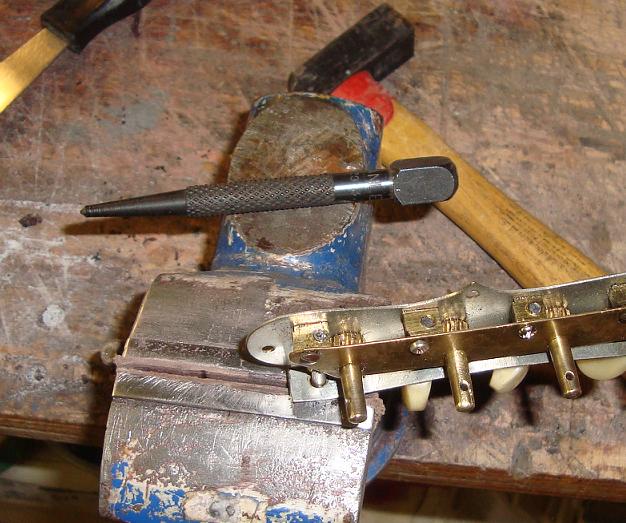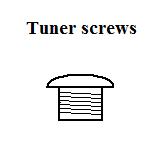|
Repair of Enclosed Tuners |
|
 |
Enclosed tuners are typical of older
mandolins, perhaps from the 1890 to 1910. They were generally replaced
by strip tuners, as the cut-away behind the head, needed to fit enclosed
tuners, tended to make the head very weak. The change-over was not
uniform though, and there seems to have been a lot of overlap between the two styles.
This set demonstrates some typical problems... mismatched buttons, missing screws or badly fitting replacements. |
 |
From the outside, a beautiful
set of tuners again displays missing screws and the odd button.
Tuner screws are generally of this type.... very small with no taper.... and very difficult to find today.
|
 |
Here I have been sorting through my
collection of old screws to find suitable alternatives to the originals.
I have also removed the odd tuner button.
It is important that the small brass blocks that hold the worm ends, are held fast from both sides by screws in the inner and out plates, or the barrels will jam, or destroy the screw threads and be un-usable. |
 |
The other problem evident here, is
that the barrel has come loose from the brass block. It is held in place
only by a burring of the very end of the spindle on the outer side of
the block. If too much tension is put on the worm gear it will sometimes
pull itself through the hole, and no longer connect to the cog.
To sort out the problem, it is usually necessary to removed the button, or risk breaking it. |

|
Here you get a view from the back... the
barrel now moves in and out of the block easily, so is entirely useless.
Also visible here, are the replacement screws found to replace missing ones. They have no taper, and though they did not fit the screw thread, it was possible to force them in. The likelihood that they will need to be removed again is slim. |
 |
To repair the slipping spindle, it is
necessary to hold it very firmly in a vice by the button end, so that
you can tap the other end with a punch. The idea is that you are trying
to make an indentation in the end of the spindle, which will force out
the sides, and thus hold it in the brass block
Finally, from my old button collection, I found one that better matched the originals to replace the odd button. Any that really cant be fixed, or are missing several pieces, I keep for spares. |
